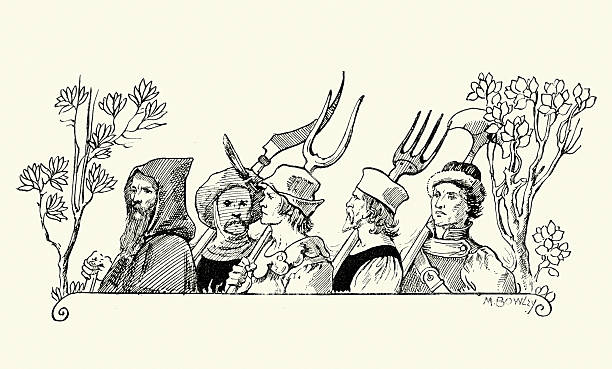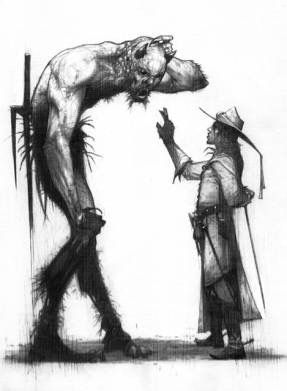What makes a monster a monster and not just a particularly ugly or strange animal? It doesn’t seem like a difficult question, but entire books have been written to try to answer it*. Leafing through some of these texts, we find several interesting things.
1. A monster is menacing
The monster in a work of fiction can be friendly (Monsters Inc.), heroic (Swamp Thing), genial (The Munster Family), ridiculous (Scooby-Doo). But in horror, which is generally intended to frighten, or cause discomfort or discomfort to the reader, the most notable characteristic of this creature is to be menacing, i.e. dangerous.
A) Dangerous in a concrete way
The most direct way to make a monster dangerous is to make it lethal. A creature that can kill or maim is a good example of a menacing monster. Literature is full of them: The cenobites in The Hell-bound Heart (Clive Barker), the human/fish hybrids in “The Shadow Over Innsmouth” (H.P. Lovecraft), the monster in Frankenstein (Mary Shelley), the vampire in Dracula (Bram Stoker), the daddy in The Shining (Stephen King), the mansion in The Haunting of Hill House (Shirley Jackson), even the cat in “The Black Cat” (Edgar Allan Poe).
The monster in literature can be an ordinary human (King), a supernatural being (Barker, Stoker), an animal (Poe), an object or thing (Jackson) or what we would call an aberration (Lovecraft, Shelley).
B) Dangerous in an abstract way
Sometimes, the monster is not physically menacing, but psychologically, morally or socially. They’re beings that don’t destroy the body (or not only the body), but the identity (“The Horla” by Guy de Maupassant), that disrupt the established moral order (Lost Souls by Poppy Z. Brite), or that seek to impose a new social order (“The Shadow Over Innsmouth”).
Also menacing are monsters that reactivate in the protagonist and the reader some childhood fears, such as the fear of being devoured or castration (Stephen King’s It; Ray Bradbury’s Something Wicked This Way Comes), or that threaten to make sexual fears and traumas conscious (Joseph Sheridan le Fanu’s Carmilla; Charlotte Perkins Gilman’s “The Yellow Wall-Paper”).
2. A monsters is impure
A common characteristic among monsters in horror literature is the repulsion they cause on a physical level; in other words, the protagonists of these stories react with disgust or rejection to these creatures, and do their best not to come into contact with them. This is due to the interstitial or contradictory nature of monsters, which present a conflict between two or more cultural categories. It is like being in the presence of dirt or human waste in a space that should be clean, such as a kitchen or living room.
The impurity of literary monsters, is achieved in 5 different ways, to wit:
A) Fusion
Fusion activates conflict through the combination of two or more opposing cultural categories, which may be visually perceptible or of an ontological order, for example: life/death (vampires, mummies, zombies); animal/human (“The Fly” by G. Langelaan; the pig men in William Hope Hodgson’s The House on the Borderland); animate/inanimate (haunted houses, the puzzle in The Hell-bound Heart); intelligence/instinct (“The Black Cat”); tangible/intangible (“The Horla”); innocence/evil (“The Decapitated Chicken” by Horacio Quiroga).
Fusion is constructed by condensing two or more opposites in the same character (or object), which in horror literature can be none other than the monster.
B) Fission
In the case of fission, the contradictory elements are distributed in different but metaphysically related entities, as occurs with the double or the changeling.
Temporal fission. Fission divides a being in time. For example, the figure of the werewolf, where beast and human occupy the same space/body, but at different times; this monster embodies a categorical contradiction (animal/human) that is distributed in time. The Strange Case of Dr. Jekyll and Mr. Hyde is the most famous example of a monster created through temporal fission.
Spatial fission. This is two separate but related bodies, a fission that divides a being in space, multiplying it. For example, the double in Oscar Wilde’s The Picture of Dorian Grey, or any work about the doppelgänger. This fission takes place in two modalities:
- The double. It represents the dark, the hidden or repressed that comes to light, and causes horror by contradicting accepted cultural, moral or social categories. The double performs the evil acts that the original would not commit. Poe’s “William Wilson” and E.T.A. Hoffmann’s The Devil’s Elixirs are examples of this form of fission.
- The imposter. The monster is either a replacement for the original (usually human), or an impostor trying to impersonate it. If the impostor really is, it is an emotionless being. If there’s been no such replacement, and it’s only imagined by someone, it’s a psychotic disorder, known as Capgras Syndrome. Horror comes into play when the boundaries between the two are unclear. The Case of Lovecraft’s Charles Dexter Ward is paradigmatic on the subject of the impostor.
These divisions turn the characters into symbols representing categorically distinct or opposing elements, while in the fusions, contradictory elements are amalgamated into a single symbol that contains them. Condensation and division allow for the projection of themes of interstitiality, cultural contradictions and impurity.
C) Magnification
To cause horror, we can take a real creature, associated with a feeling of revulsion, or that has unpleasant characteristics from a cultural point of view, and increase its size considerably. Giant spiders would be the most obvious choice. Spiders are creatures that cause repulsion to most people even at their original size. Increasing their dimensions, even to the size of a dog, let alone a building, has the power to increase the horror experienced. An example of a larger than normal, though not colossal, spider is found in M.R. James’ “The Ash-tree,” and in Brian Lumley’s “Cement Surroundings,” there are some huge worms.
*Reduction. One variation is reduction, as evidenced by stories about goblins and evil elves, or Horacio Quiroga’s “The Feather Pillow”, where the typical vampire figure is taken and reduced to the size of an insect.
D) Multiplication
Instead of taking these beings and making them giants, it’s a matter of multiplying them in number. The mass of these creatures becomes the monster. Attacks by spiders, ants, locusts and rats are among the most popular. These hordes not only cause distress because of their repulsive nature, but are driven by an evil intelligence that seems to seek the annihilation of human beings. Lovecraft’s story “The Rats in the Walls” comes to mind, as does Hodgson’s “The Voice in the Night,” where evil fungi sprout everywhere and threaten to cover the entire world.
E) Horrific metonymy
The monster doesn’t need to be repulsive in itself, it’s enough that it relates to repulsive beings and objects to cause horror. Count Dracula is a figure who, physically, does not appear abnormal, and in some readings may even appear seductive, but he surrounds himself with rats and other nauseating creatures, which’s enough to make him repulsive by association.
In Clive Barker’s The Damnation Game, the monster has a normal appearance, but his assistant is a zombie who throughout the novel goes through a process of putrefaction that consumes him more and more. In “The Abominations of Yondo” by Clark Ashton Smith, the monster is the desert of Yondo which, although not a living being, becomes a cause of horror because of its association with all kinds of abominations, such as corpse-colored insects that chase the protagonist, to the eyeless creature similar to a dog and at the same time to a spider, which tries to hunt him using its sense of smell.
3. So… break the rules
A monster must be, by default, threatening, this is achieved by making it dangerous. A monster can also be impure. Impurity is what turns a monster into a monster of horror. This is achieved through: Fusion and fission, which allow the creation of horror biologies; magnification and multiplication, which are ways of increasing the power of creatures already associated with repulsive feelings and rejection; and horrific metonymy, which is a way of emphasizing the impure nature of a creature by associating it with reviled beings and objects. Monsters in horror literature are a compound of danger and disgust.
Some of the most interesting creatures are those that use more than one of these categories. In the aforementioned “Las abominaciones de Yondo” we not only have the metonymy of horror by associating the desert with repulsive beings, we also have the multiplication by multiplying the horrors that the protagonist encounters. In the same way, Dracula is not only a repulsive being by association with rats and spiders, he also incurs in fusion by being an undead, and in temporal fission, by becoming a wolf.
Monsters break the reality rules of fiction. In the same way, monsters in a role-playing game, if we want them really scary and horrifying, must break the rules of the reality of this other fiction. A monster is not created in the same way as a player character and should not follow the same rules.
If you wish, a monster can attack several times, or regenerate its life points, or be immune to certain kinds of attacks, or whatever madness comes to mind. Of course, in the hands of a fair and impartial referee, a monster, even if it breaks the rules of reality, will not break its own rules.

*Suggested reading: Noël Carroll, The Philosophy of Horror Or, Paradoxes of the Heart; Mary Douglas, Purity and Danger: An Analysis of Concepts of Pollution and Taboo; W. Scott Poole, Monsters in America: Our Historical Obsession with the Hideous and the Haunting; y Phillip Athans, Writing Monsters.
Now go make some nasty monsters!
Suggested soundtrack

















